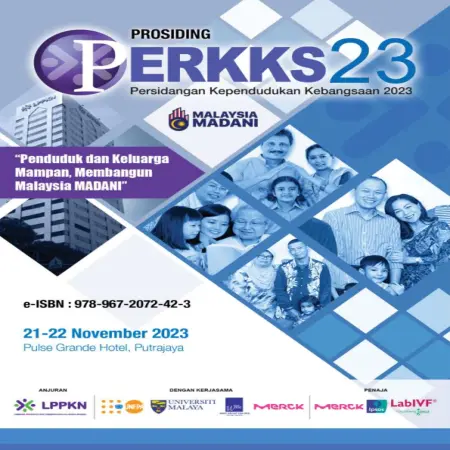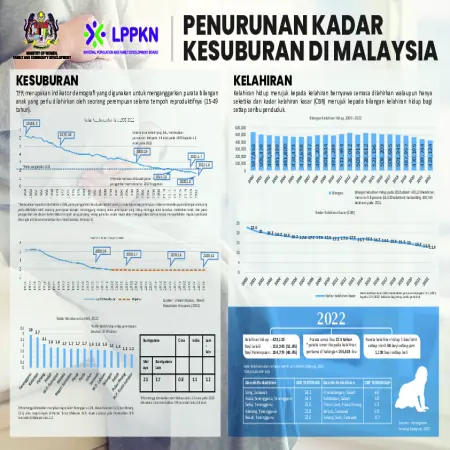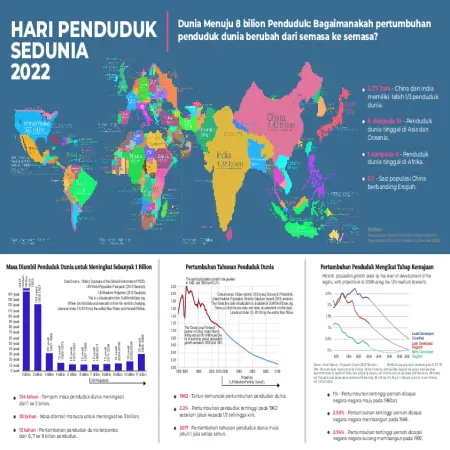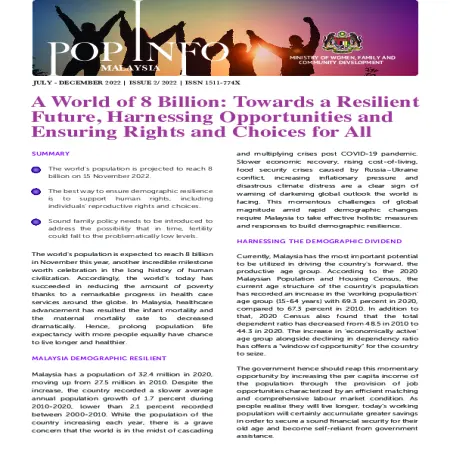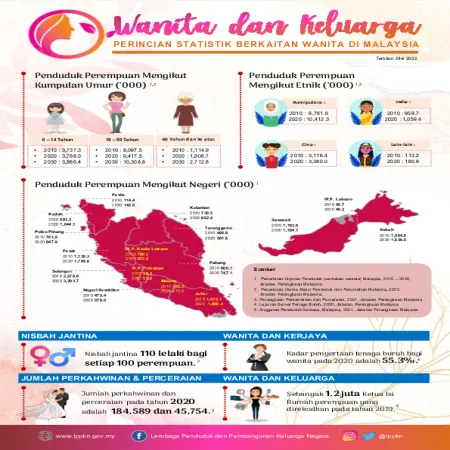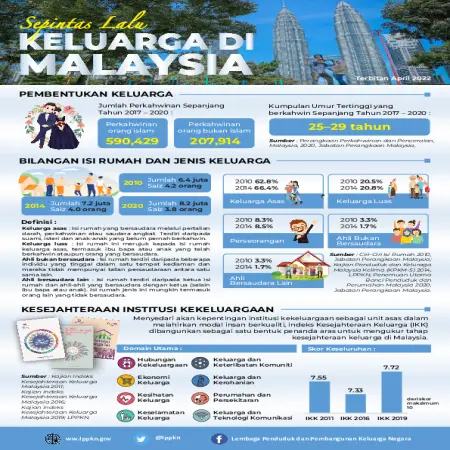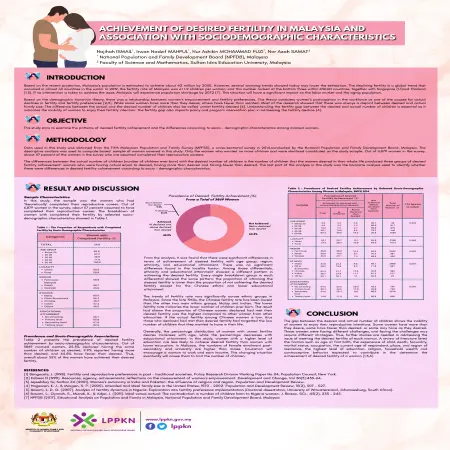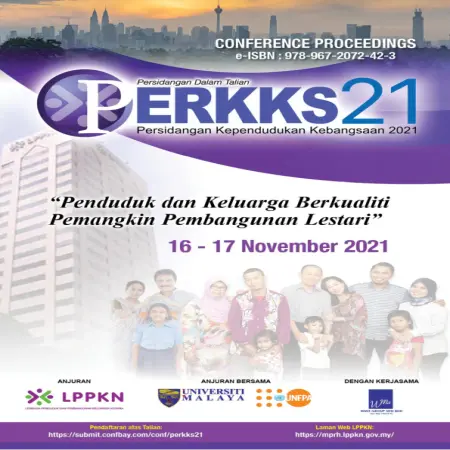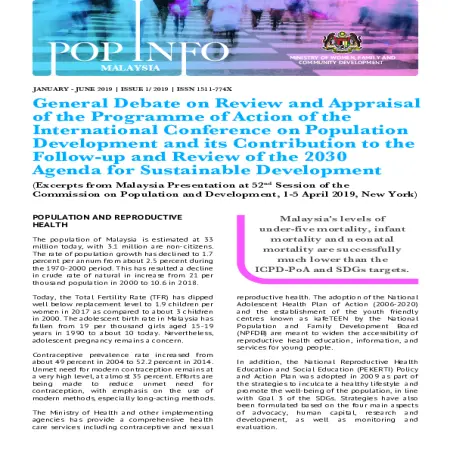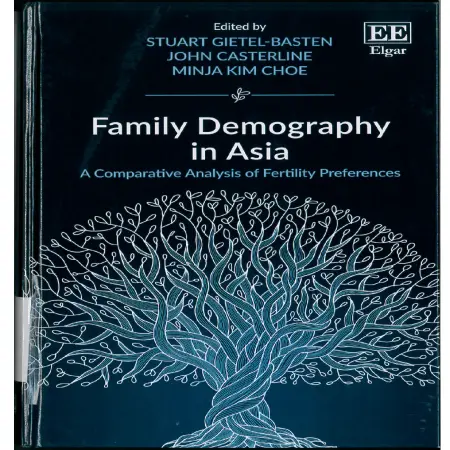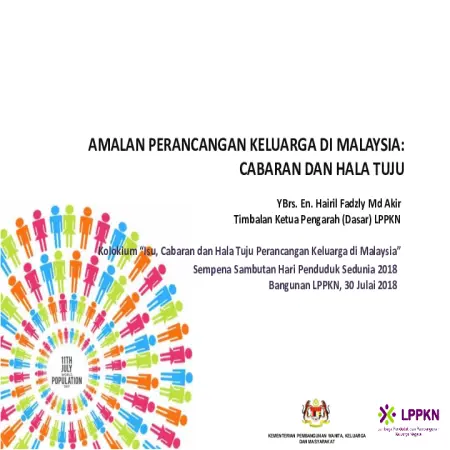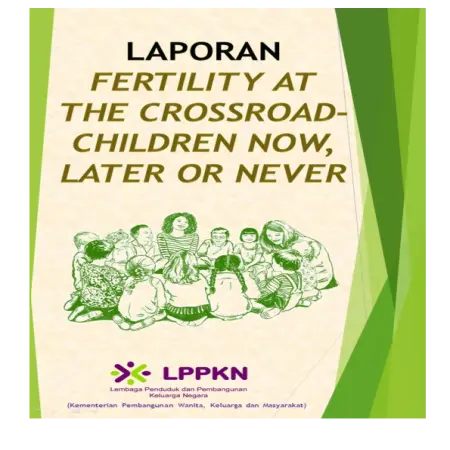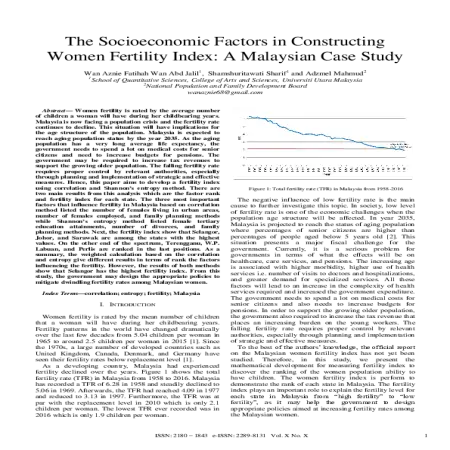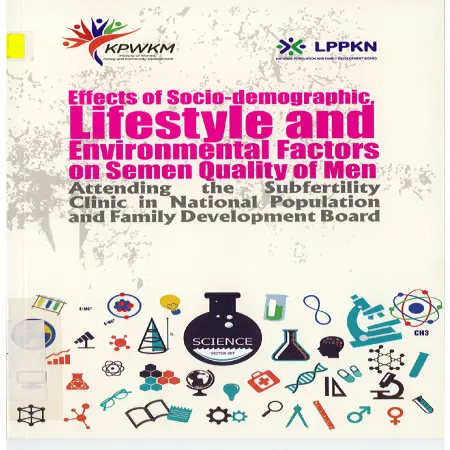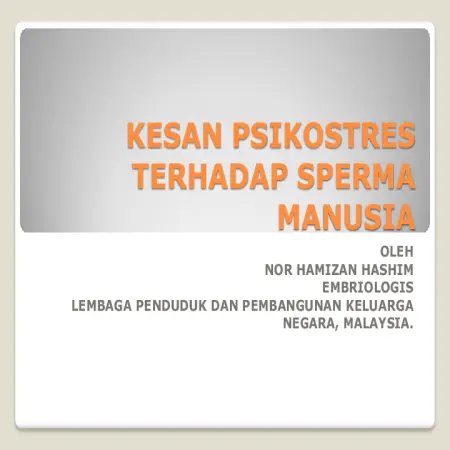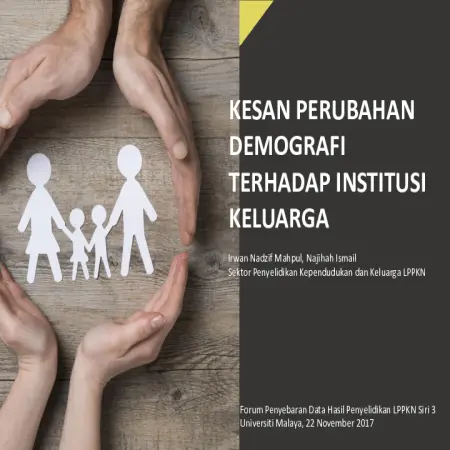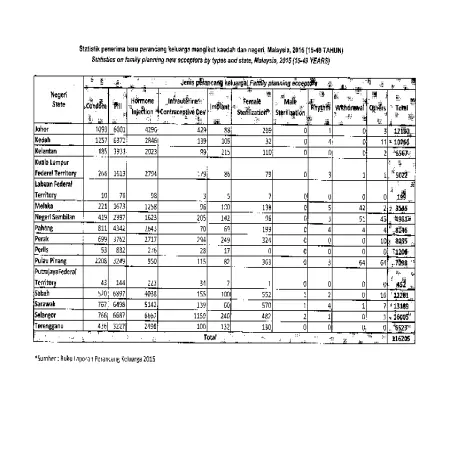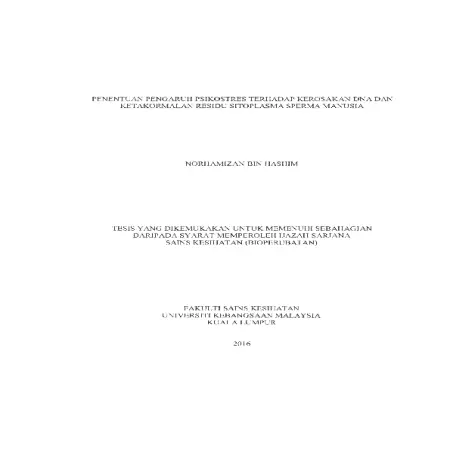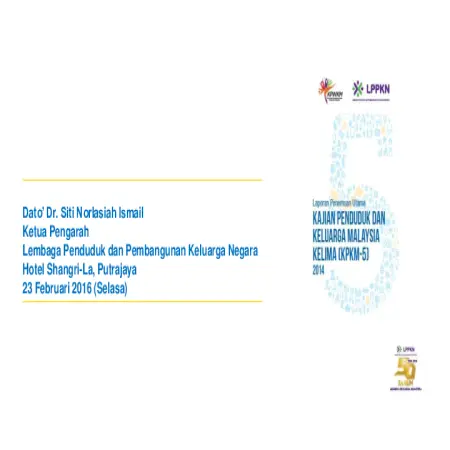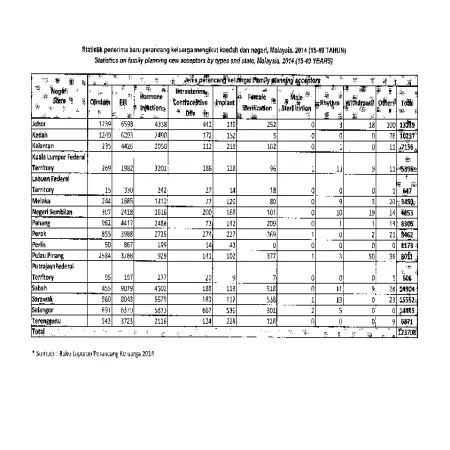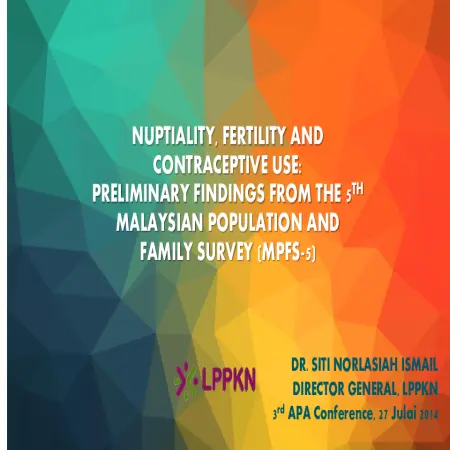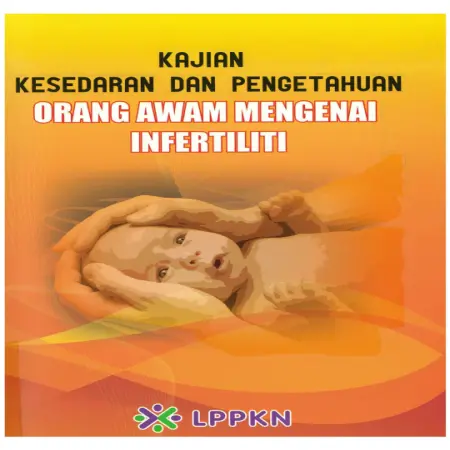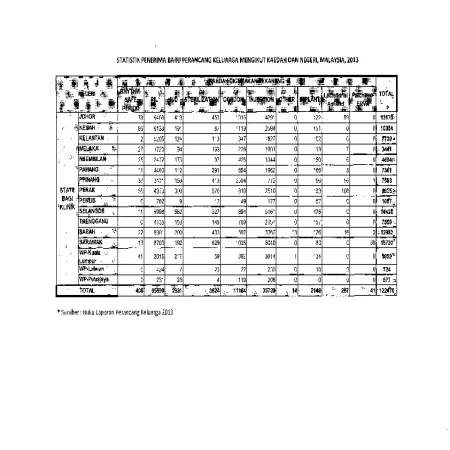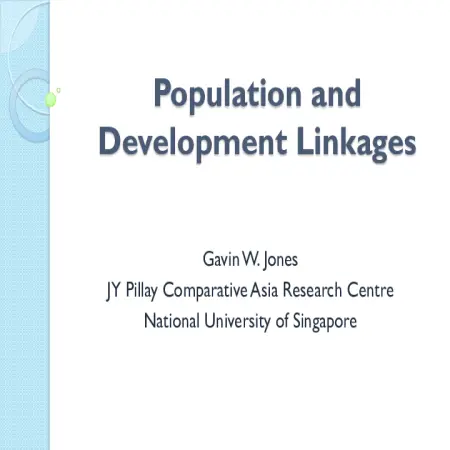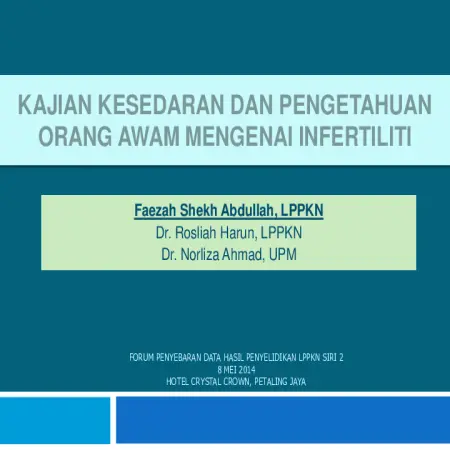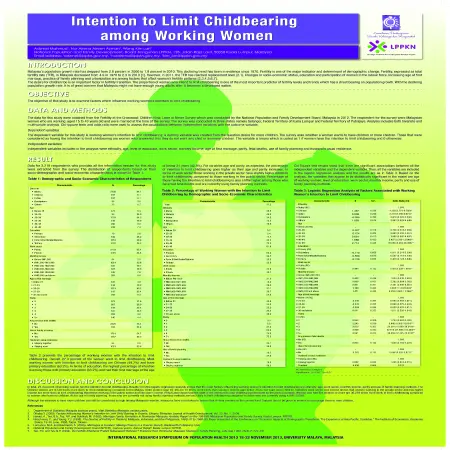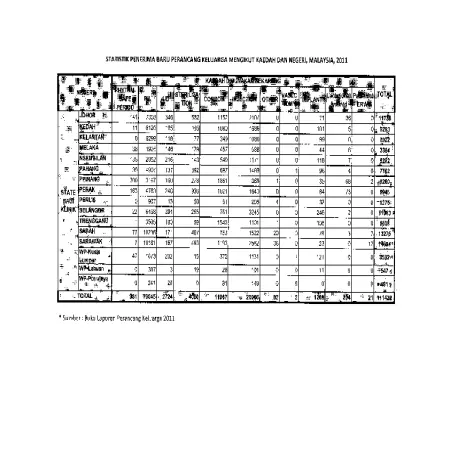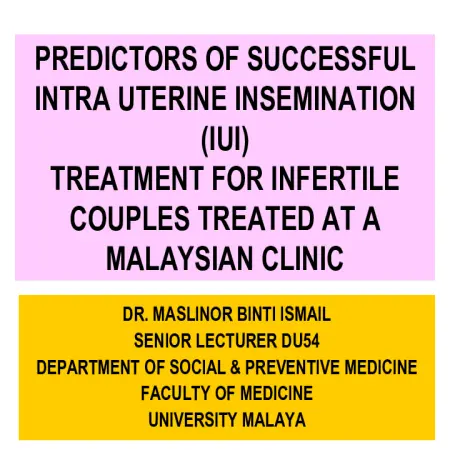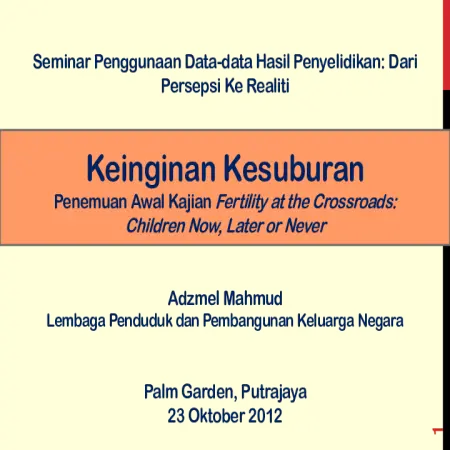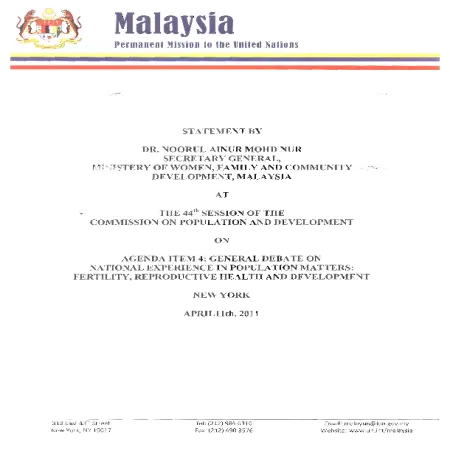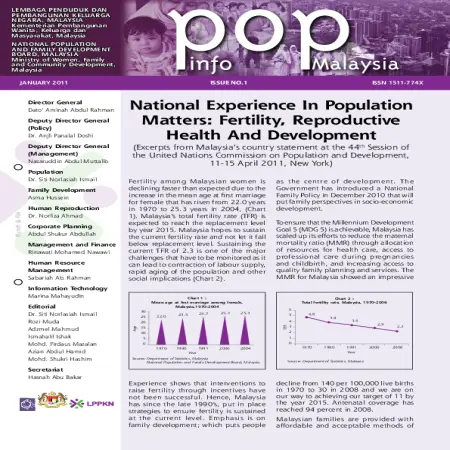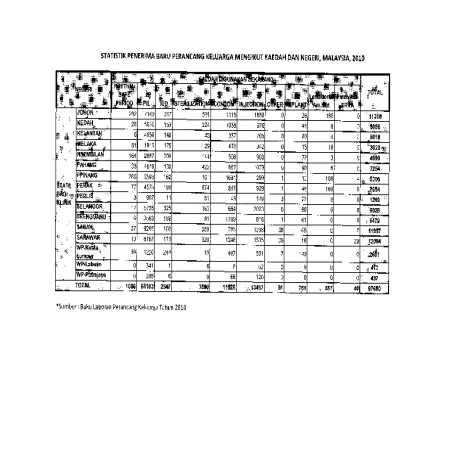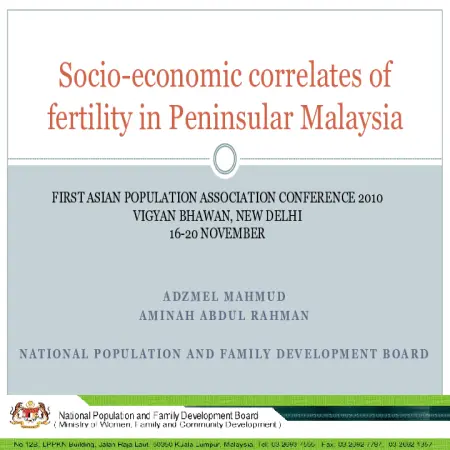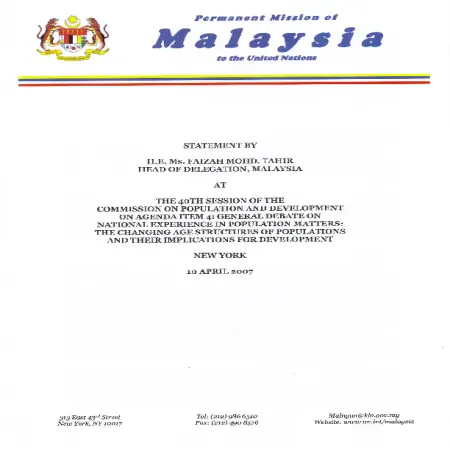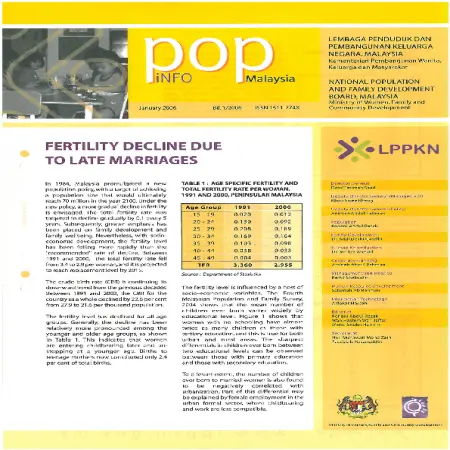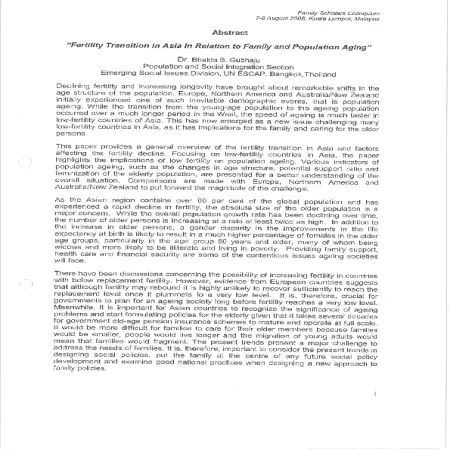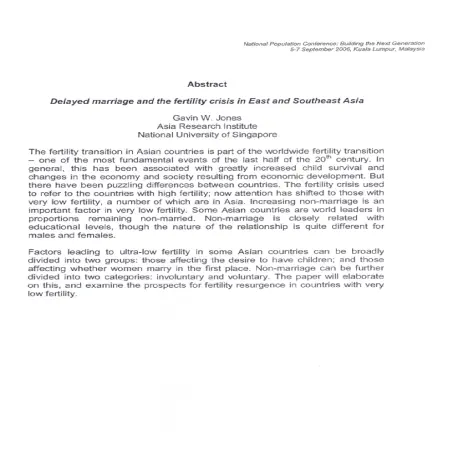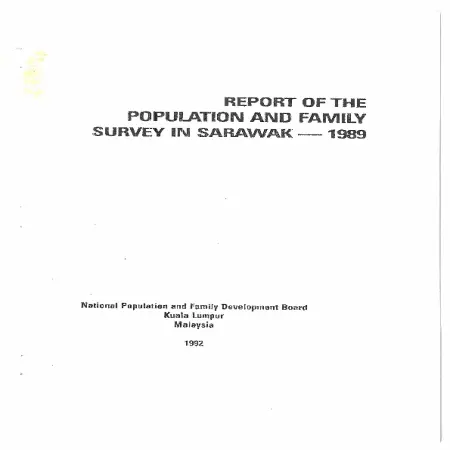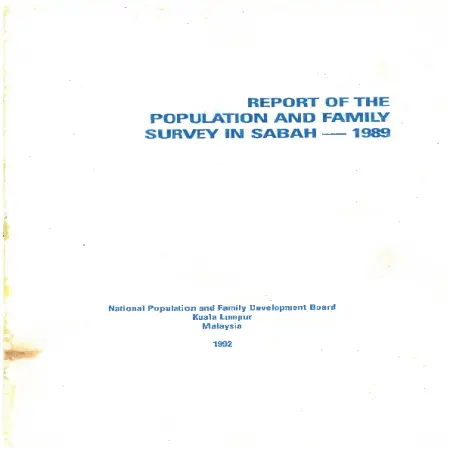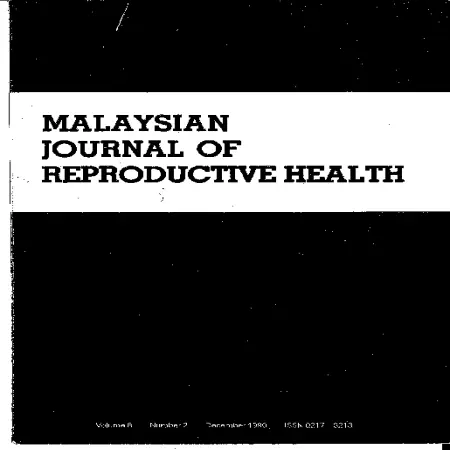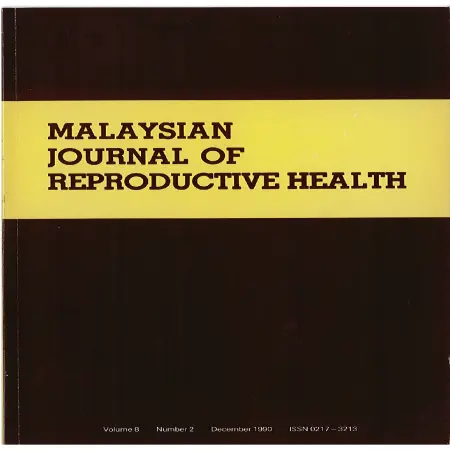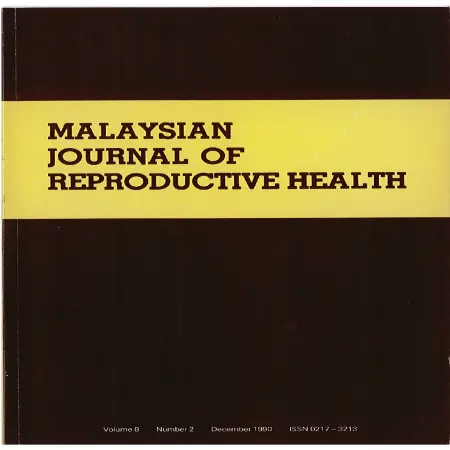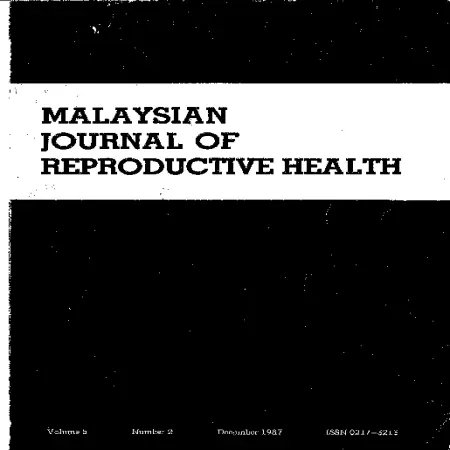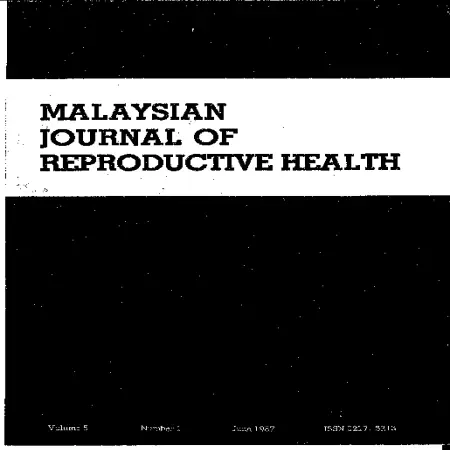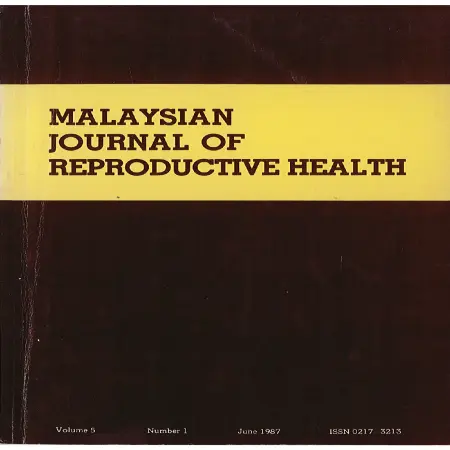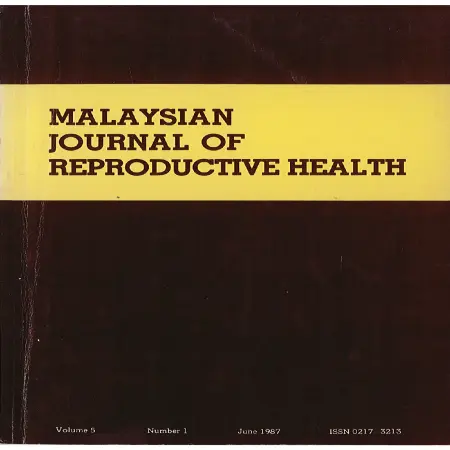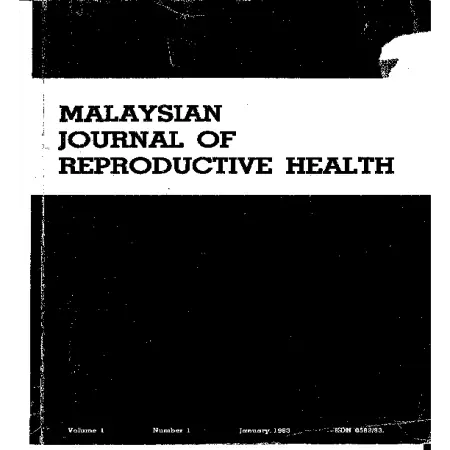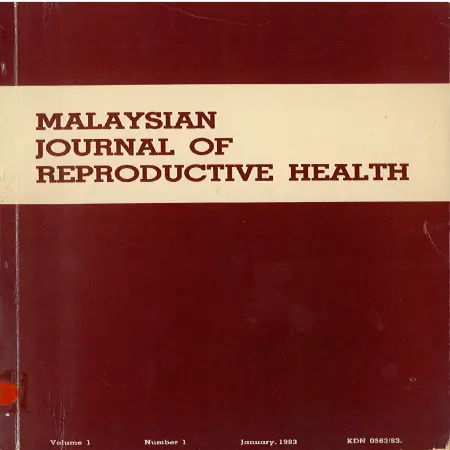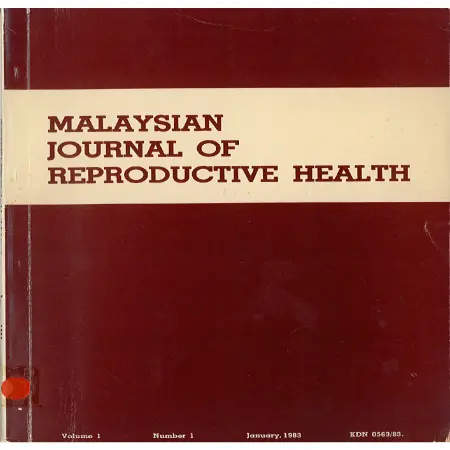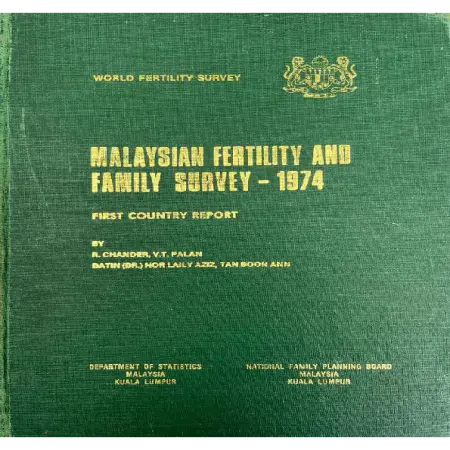TOPICS
Results for Topics : "Fertility"
2024 (1)
|
|
SDGS and the impact of megatrends on Families: perspectives from Malaysia
Item Type: Conference or Workshop Item
Editor:
Year: 00/05/2024
Abstract: 57th Commissions on Population and Development (CPD57): Assessing the status of implementation of the Programmed of Action of the International Conference on Population and Development and its contribution to the follow-up and review of the 2030 Agenda for Sustainable Development during the decade of action and delivery for sustainable development. Strengthening Malaysian Families in era of megatrends, National Population and Family Development Board Malaysia (NPFBD) had LPPKN Family Centre, Nur Sejahtera Clinic Services, Population and Family Research, Training and education (family), Counseling service and program, online accessibility etc.
|
|
|
|
2023 (2)
|
|
Prosiding Persidangan Kependudukan Kebangsaan 2023 (PERKKS 23): “Penduduk dan Keluarga Mampan, Membangun Malaysia MADANI”
Item Type: Book
Editor:
Year: 00/12/2023
Abstract: Collection of papers presented during the 2023 National Population Conference (PERKKS 23), 21-22 November 2023, Pulse Grande Hotel, Putrajaya.
|
|
|
|
|
|
Penurunan Kadar Kesuburan Di Malaysia
Item Type: Infographic
Editor:
Year: 00/10/2023
Abstract: Total Fertility rate (TFR) is a demographic indicator used to estimate the average number of children a woman should give birth to during her reproductive period. The findings of a poll in Sarawak found that the total TFR for the state of Sarawak is decreasing drastically. 12.6% of couples have had or are experiencing fertility problems and it is difficult to conceive within a year after marriage.
|
|
|
|
2022 (8)
|
|
Prosiding Persidangan Kependudukan Kebangsaan 2022 (PERKKS 22): “Pemerkasaan Penduduk dan Keluarga, Teras Negara Maju”
Item Type: Book
Editor:
Year: 00/12/2022
Abstract: Collection of papers presented during the 2022 National Population Conference (PERKKS 22), 10-11 November 2022, Bangi Resort Hotel, Selangor.
|
|
|
|
|
|
A world of 8 billion: Towards a resilient future, harnessing opportunities and ensuring rights and choices for all
Item Type: Newsletter
Editor:
Year: 00/11/2022
Abstract: The world's population is projected to reach 8 billion on 15 November 2022. The best way to ensure demographic resilience is to support human rights, including individuals' reproductive rights and choices.
|
|
|
|
|
|
The impact of ageing, population growth and fertility rate on economic growth: new evidence using dynamic heterogeneous panel
Item Type: Book Section
Editor:
Year: 00/00/2022
Abstract: Over the last century, a declining fertility and mortality rate have led to an ageing population. This trend was primarily found in Europe and North America prior to the past two decades, but it has since become widespread. Due to altered reproduction patterns and rising life expectancy, the ageing population will probably increase.
|
|
|
|
|
|
Penurunan kadar kesuburan penduduk di Malaysia: Implikasi dan intervensi
Item Type: Book Section
Editor:
Year: 00/00/2022
Abstract: The fertility rate of the national population has decreased from 6.8 children in 1957 to 4.9 children in 1970. This rate continued to decline to 3.9 in 1980, 3.3 in 1990, 2.7 in 2000, 2.2 in 2010 and then 1.7 in 2020. The United Nations projects that the fertility rate of the country’s population will remain at a level between 1.7 and 1.8 until 2100.
|
|
|
|
|
|
Kadar kesuburan mengikut umur: suatu perbandingan perbezaan ufuk ramalan
Item Type: Book Section
Editor:
Year: 00/00/2022
Abstract: Population ageing is facing by most countries today. This issues is influenced by factors such as increased life expectancy, migration and decreased fertility rates. The optimal fertility rate is 2.1 which means the average birth rate for a woman is able to replace herself and her partner. However, Malaysia has recorded a worrying situation since 2013 when the total fertility in the country was below 2.1, which is below the global fertility rate. A low fertility rate will increase the old-age dependency ratio and in turn affect the country’s economic growth. This study aims to analyze the pattern and forecast of fertility rates in Malaysia for the years 2001 to 2016 by using Lee-Carter model.
|
|
|
|
2021 (2)
|
|
Achievement of desired fertility in Malaysia and association with sociodemographic characteristics
Item Type: Scientific Poster
Editor:
Year: 00/00/2021
Abstract: This study aims to examine the patterns of desired fertility achievement and the differences according to socio - demographic characteristics among married women.
|
|
|
|
|
|
The impact of aging and fertility rate on economic growth in Malaysia: new evidence using ARDL model
Item Type: Book Section
Editor:
Year: 00/00/2021
Abstract: Population aging and the health status of the community are the primary agenda in the achievement of the Sustainable Development Goals 2030 (SDG, 2030). However, current trends in the world have shown a rapid increase in the aging population rate, whereas the birth rate has shown a downward trend. Malaysia is no exception in this regard, which is expected to become an old country status by 2030 when the population aged 60 years and above reaches 15% of the total population.
|
|
|
|
2020 (1)
|
|
Seroprevalence and factors associated with chlamydia trachomatis Infection among subfertile couples attending local public subfertility clinic
Item Type: Thesis
Editor:
Year: 00/00/2020
Abstract: Chlamydia trachomatis is one of the agents that cause the sexually transmitted infections called chlamydia. People practicing risky sexual behaviours such as having multiple sex partners, exercising sexual intercourse at an early age, and undergoing unprotected sexual
intercourse (without condom) with casual partners, are at risk of getting Chlamydia trachomatis infection. One of the significant, long term implications of risky sexual behaviours and sexually transmitted infection is infertility problems. The objectives of this study are to determine the seroprevalence of Chlamydia trachomatis (CT) among subfertile couples (husband and wife) of The Lembaga Penduduk dan
Pembangunan Keluarga Negara (LPPKN) Subfertility Clinic and the factors associated with it (i.e. socio-demographic, duration of marriage, infertility factor, knowledge, attitude, practice of risky sexual behaviour (RSB) and predictors of Chlamydia trachomatis infection). The study is a cross-sectional study involving 112 infertile couples who underwent fertility treatment at LPPKN Subfertility Clinic from February 2018 until February 2019. Sociodemographic factors, duration of marriage, infertility factor, knowledge, attitude and practice (KAP) of risky sexual behavior (RSB) variables were determined via self-administered
questionnaire that includes close ended questions. Meanwhile, Chlamydia trachomatis antigen and antibody (CT IgG) were determined via Enzyme Linked Immunosorbent Assay (ELISA) and rapid visual immunoassay test kit. This approach is selected to detect past and
current infections of Chlamydia trachomatis through antibody and antigen detection in the blood serum, endocervical swab and urine samples. The response rate of this study was 97.39%. Majority of the respondents were aged between 25-34 years old and dominated by Malay ethnicity. Half of the respondents were among those with tertiary level of education and working in the private sector. In term of duration of marriage, half of the samples were couples who have been married for 3-7 years with majority of them had primary infertility. The female factor was reported to be the most dominant, followed by the unexplained factor and male factor. The seroprevalence of Chlamydia trachomatis among subfertile couples was 22.1% with 14.7% in husbands and 17.9 %, was reported among wives. In terms of knowledge, the results showed that most couples had high level of knowledge
about risky sexual behaviours with a score of more than the mean (> 6) for both husbands and wives. Meanwhile, each husband and wife group had positive attitude towards risky sexual behavior. Approximately, 35.7% of husbands and 12.5% of wives were engaged with risky sexual behavior while a higher percentage of premarital sex was reported among the husbands compared to the wives. The chi-square results showed no association between CT status and socio -demographic factors, marital status and knowledge of RSB among subfertile couples. A significant association was recorded between CT and practices of RSB among couples (p< 0.05) particularly among those with multiple sex partners and husbands who had premarital sex (p<0.05). However, the Binary Logistic Regression analysis showed that none of the selected variables were significant predictors of CT status among the couples (p> 0.05). This study has determined that the seroprevalence of Chlamydia trachomatis (22.1%) and practices of risky sexual behavior among subfertile couples were high. Even though the results have shown no association between the dependent and independent variables, our finding has given an evidence based detection of past infection of Chlamydia trachomatis among
subfertile couples. The practice of RSB has interrelated risk of getting CT and its long term consequences particularly on women reproductive system. Since the awareness on CT among public is considered low, it is crucial to sensitize them about it to ensure early detection and prevention. Therefore, CT screening is strongly recommended to be integrated in fertility work up. treatment and be promoted among sexually active adolescents and those young in age.
|
|
|
|
2019 (1)
|
|
General debate on review and appraisal of the programme of action of the International Conference on Population Development and its contribution to the follow - up and review of the 2030 agenda for sustainable development
Item Type: Newsletter
Editor:
Year: 00/00/2019
Abstract: The Population of Malaysia is estimated at 33 million today with 3.1 million are non-citizens. The rate of population growth has declined to 1.7 per cent per annum from about 2.5 per cent during the 1970-2000 period. Malaysia is moving towards becoming one of the aged countries by 2030. The fast pace of ageing population is as a result of longer life expectancy and rapid decline in Total Fertility Rate (TFR).
|
|
|
|
2018 (4)
|
|
Development of Malaysian women fertility index
Item Type: Article
Editor:
Year: 00/11/2018
Abstract: A fertility rate is a measure of the average number of children a woman will have during her childbearing years. Malaysia is now facing a population crisis and the fertility rate continues to decline. This situation will have implications for the age structure of the population where percentages of senior citizens are higher than percentages of people aged below 5 years old. Malaysia is expected to reach aging population status by the year 2035. As the aging population has a very long average life expectancy, the government needs to spend a lot on medical costs for senior citizens and need to increase budgets for pensions. The government may be required to increase tax revenues to support the growing older population. The falling fertility rate requires proper control by relevant authorities, especially through planning and implementation of strategic and effective measures. Hence, this paper aims to develop a fertility index using correlation and Shannon's entropy method. The results show that Selangor, Johor, and Sarawak are among the states with the highest values of the fertility index. On the other end of the spectrum, Terengganu, W.P. Labuan, and Perlis are ranked in the last positions according to the fertility index. The information generated from the results in this study can be used as a primary source for the government to design appropriate policies to mitigate dwindling fertility rates among Malaysian women.
|
|
|
|
|
|
Fertility preferences in Malaysia
Item Type: Book Section
Editor:
Year: 30/11/2018
Abstract: Most countries have been experiencing changes in fertility pattern over the last few decades. Fertility transition from high to low is a relatively recent phenomenon in Malaysia. The total fertility rate (TFR) had declined from 4.9 children per woman in 1970 to 4.0 in 1980. It has continued to fall and has reached the replacement level of 2.1 in 2010. This chapter provides the trend analysis and a comparative analysis of fertility trends to explain the fertility transition of Malaysia’s population. Data used in this study were obtained from Department of Statistics, Malaysia and Fifth Malaysian Population and Family Survey, 2014. The result of this study showed that the fertility rate between age groups was higher among Malay than other ethnics since 1991–2010. Across all ages, the fertility rate has a negative correlation with the educational level where women with tertiary education tend to have fewer children compared to less educated women. This study also presents the fertility desire in Malaysia. There is a negative correlation between age group and fertility desire. In addition, the desire to stop childbearing is found to be stronger when women have had three living children. The findings of this study will help policy makers to plan programmes to improve the fertility rate in Malaysia.
|
|
|
|
|
|
Amalan perancangan keluarga di Malaysia: cabaran dan hala tuju
Item Type: Conference or Workshop Item
Editor:
Year: 00/00/2018
Abstract: Family planning allows people to attain their desired number of children and determine the spacing of pregnancies. It is achived through use of contraceptive method and the treatment of infertility. Proportion of women of reproductive aged 15-49 years who have their need for family planning satisfied with modern methods.
|
|
|
|
|
|
Laporan fertility at the crossroad-children now, later or never
Item Type: Research Report
Editor:
Year: 00/00/2018
Abstract: This study was to identify the socio-economic and psychological factors that influence the decision of women working in the public and private sectors to want to have children now, postpone pregnancy or do not want to have another child/children. It also to identify forms of support that can be provided by employers in an effort to create a family -friendly work environment. Nowadays, the issue of declining fertility rates is becoming a global issue, not just in among developed countries even in developing countries. Most countries have experienced fertility decline since the 1970s. United Nations Projections (UN) indicates most countries in the Asia Pacific region will experience a decline total fertility rate (TFR) until 2015-2030. Countries like China, Japan and Singapore have achieved TFR below the substitution level for decades ago. Rapid socio -economic development in Malaysia over the past five decades
has resulted in a decrease in births and deaths as well as an increase in migration. Malaysia is currently in the second phase of a demographic transition where fertility rates are increasing decreased while the percentage of the elderly population increased. Decrease in rate
mortality and fertility are closely linked to improved quality of life giving
significant impact on the growth and size of the Malaysian population.
|
|
|
|
2017 (6)
|
|
The socioeconomic factors in constructing women fertility index: a Malaysian case study
Item Type: Article
Editor:
Year: 01/06/2017
Abstract: Women fertility is rated by the average number of children a woman will have during her childbearing years. Malaysia is now facing a population crisis and the fertility rate continues to decline. This situation will have implications for the age structure of the population. Malaysia is expected to reach aging population status by the year 2035. As the aging population has a very long average life expectancy, the government needs to spend a lot on medical costs for senior citizens and need to increase budgets for pensions. The government may be required to increase tax revenues to support the growing older population. The falling fertility rate requires proper control by relevant authorities, especially through planning and implementation of strategic and effective measures. Hence, this paper aims to develop a fertility index using correlation and Shannon's entropy method. There are two main results from this analysis which are the factor rank and fertility index for each state. The three most important factors that influence fertility in Malaysia based on correlation method listed the number of females living in urban areas, number of females employed, and family planning methods while Shannon's entropy method listed female tertiary education attainments, number of divorces, and family planning methods. Next, the fertility index show that Selangor, Johor, and Sarawak are among the states with the highest values. On the other end of the spectrum, Terengganu, W.P. Labuan, and Perlis are ranked in the last positions. As a summary, the weighted calculation based on the correlation and entropy give different results in terms of rank the factors influencing the fertility. However, the results of both methods show that Selangor has the highest fertility index. From this study, the government may design the appropriate policies to mitigate dwindling fertility rates among Malaysian women.
|
|
|
|
|
|
Stress buat lelaki jadi kurang subur?
Item Type: Article
Editor:
Year: 00/03/2017
Abstract: Fertility problems are now increasing from time to time around the world. According to the World Health Organization (WHO 2010), infertility can be rooted; 40% of male factors or and 40% of female factors and 20% are from unknown factors (idiopathy).
|
|
|
|
|
|
Effects of socio-demographic, lifestyle and environmental factors on semen quality of men attending the sub fertility clinic in National Population and Family Development Board
Item Type: Research Report
Editor:
Year: 02/01/2017
Abstract: Couples are considered infertile if they are unable to conceive after one year of regular unprotected sex. The impact of lifestyle and environment on human fertility may vary depending on aetiology, demographic characteristics, genetic variation and other factors. As used by previous researchers, semen parameters were used to measure male infertility. Therefore, a decrease in semen quality is considered as a major factor in male infertility (http://en.wikipedia.org/wiki/Semen_quality). Previous studies (Kidd et al.2001,Eskenazi et al.2003, de La Rochebrochard and Thonneau 2003) have found that older men tend to have lower semen quality than younger ones. Testicular hyperthermia (elevated temperature) also has been known to affect male fertility. Men who like taking hot baths or sit in a sedentary position for a long time are at risk of having infertility. The objectives of this study are to identify the relationship between socio-demographic profile, lifestyle and environmental factors and semen quality, and to identify risk factors of poor semen quality among men attending the National Population and Family Development Board's (NPFDB) Subfertility Clinic. This study was done in Andrology Laboratory, NPFDB. Five hundred men from couples having their first infertility consultation between September 2010 abd June 2011 were recruited. Each patient was required to register, deposit semen and fill in the quesstionnaire. Sperm concentration, morphology and motility from semen analysis were used to study the relationship between semen quality and independent variables. Reference limits used were 15 cells x 10'6/ml, 4% and 40 %, respectively (World Health Organization, 2010). For statistical analysis, descriptive statistic, t test and ANOVA were used; 0.05 alpha value was chosen. Results showed that one-third of the study population were between 26 to 30 years of age and another one third were aged between 31 to 35 years old; mean age was 33.2. majority were Malays (71.2%), resided in Selangor (64.3%) and professionals (41.6%). Semen quality showed a negative relationship (p<0.05) with age. Meanwhile, sperm motility varied significantly for different ethnic group. Chinese (57.75%) had the highest motile-sperm compared to Malays (53.44%) and Indians (46.60%). Among lifestyles variables, frequency of sexual intercourse had a posive relationship (p<0.05) with sperm motility, whilst sedentary position had negative relationship (p<0.05) with the latter. Regression analysis was used to predict the risk factors of poor semen quality. This study found that men above 30 years old were two times more likely to have low sperm motility than men in the twenties. Moreover, less frequent sexual activity between couples was more likely (p<0.05) to have abnormal sperm compared to those who had sexual intercourse more frequently. In conclusion, this study suggested that age over 30 years and infrequent sexual activity were the risk factors to lower semen quality. Even though not regarded as a risk factor, sedentary work position had a negative impact on sperm motility. These factors may affect male fertility and cause difficulty in conception. Public awareness through advocacy programs and talks on infertility and its risk factors should be carried out regularly. Public education should be carried out to advice men to practice a healthy lifestyle and work life balance. This study has shown encouraging results, and should be replicated in the general population in Malaysia
|
|
|
|
|
|
Malaysian infertile men and women : do they suffer mental health issues?
Item Type: Conference or Workshop Item
Editor:
Year: 00/00/2017
Abstract: This study revealed that Malaysian infertile men and women demonstrated susceptibility to mental health problems that occurs more commonly among women than men. Thus, this study may facilitate fertility facilities to strategize and redesign better intervention for the infertile couples.
|
|
|
|
|
|
Kesan perubahan demografi terhadap institusi keluarga
Item Type: Conference or Workshop Item
Editor:
Year: 00/00/2017
Abstract: Since the 1980s, the fertility rate (TFR) has declined slowly from 4.0 to 2.0 children per woman in 2016. This means that every woman in the country at this point , on average, gives birth to 2 children in her lifetime. The rapid decline in fertility rate (TFR) has accelerated the aging process of the country. The TFR is likely to remain between 1.9 and 2.0 by 2020 and below 1.9 in the next decade. This presentation is about the impact of demographic change on family institutions.
|
|
|
|
2016 (5)
|
|
Memilih jantina bayi: bahagian 2
Item Type: Article
Editor:
Year: 00/08/2016
Abstract: From time immemorial, our ancestors practiced certain tips and diets to get the desired gender of the child. However, there is still no scientific explanation of the effectiveness and accuracy of the practice. Learn how to determine the sex of a baby from a scientific point of view.
|
|
|
|
|
|
Fertiliti dan Konsepsi - Senario memilih jantina
Item Type: Article
Editor:
Year: 00/07/2016
Abstract: The tendency to choose the sex of a baby by a couple has occurred since time immemorial due to several factors including social, cultural, economic, belief, religious, and health factors. A study conducted by the United Nations Population Fund (UNPF) has outlined three main factors of child gender selection practices and gender imbalance for a society.
|
|
|
|
|
|
Penentuan pengaruh Psikostres terhadap kerosakan DNA dan ketakormalan residu sitoplasma sperma manusia
Item Type: Thesis
Editor:
Year: 00/00/2016
Abstract: Idiopathic infertility has been correlated with psychostress which can result in abnormality and declining semen quality in men. Nevertheless, direct relationship of semen quality and psychostress is still unclear. Hence, this study was conducted to evaluate the effect of psychostresson semen quality with emphasizing on sperm DNA damage and cytoplasm droplet abnormality. A total of 628 respondents were selected randomly among men aged between 25-45 years old were patient from LPPKN.
|
|
|
|
2015 (3)
|
|
Apa wanita perlu tahu: subur@tidak subur?
Item Type: Article
Editor:
Year: 00/05/2015
Abstract: Fertility is the ability to conceive naturally. As a measure, fertility rate is the number of children born per individual, household or population. Fertility varies according to fertility, i.e. the potential to reproduce (which is influenced by gamete production, fertilization and the ability to conceive long enough). There are several types of ovulation disorders that are 35% of the cause of infertility in women, namely anovulation. Anovulation is a condition where no ovulation process occurs or the egg process is released from the ovaries, oligovulation is an irregular ovulation process that sometimes occurs, sometimes not and the anovulation cycle is a menstrual cycle in which no ovulation process occurs at the cycle.
|
|
|
|
|
|
Nuptiality, fertility and contraceptive use: preliminary findings from the 5th Malaysian Population and Family Survey (MPFS -5)
Item Type: Conference or Workshop Item
Editor:
Year: 00/00/2015
Abstract: The current marital trend status shows more than 90 % are currently married while the percentage of divorce or separation is increasing. Next, current marital status by age group in 2014 showed that 93.1 % is currently married and 5.3 % among women 20-24 are divorce or separated. This paper discuss about nuptiality, fertility and contraceptive use from preliminary finding of the Fifth Malaysian Population and Family Survey (MPFS-5) 2014.
|
|
|
|
2014 (4)
|
|
Kajian kesedaran dan pengetahuan orang awam mengenai infertiliti
Item Type: Research Report
Editor:
Year: 00/01/2014
Abstract: The study conducted by the Human Reproductive Division, National Population and Family Development Board aims to identify the extent of the public awareness and knowledge about infertility. The sampling method of the study is convenience sampling; involving the display of questionnaires on other websites are also provided. The completed questionnaires were collected, recorded and analyzed using SPSS software. The statistical analysis carried out is descriptive statistics and the Chi-square Test.
|
|
|
|
|
|
Population and development linkages
Item Type: Conference or Workshop Item
Editor:
Year: 00/00/2014
Abstract: Demographic factors remain very important in the overall development equation, but the meaning of development remains contested, the increasing inequality in many countries’ income distribution provides a fundamental challenge to current economic systems, and the sustainability of what we have achieved remains in question. The United Nations has issued a challenge to academics and planners by claiming that the framework for population and development beyond 2014 should rest on the five thematic pillars of dignity and human rights, health, place and mobility, governance and accountability, and sustainability. Integrating population policy into overall development policy will continue to require both good analytical abilities and a broader vision of what the goals are.
|
|
|
|
|
|
Kajian kesedaran dan pengetahuan orang awam mengenai infertiliti
Item Type: Conference or Workshop Item
Editor:
Year: 00/00/2014
Abstract: The infertility rate in Malaysia is estimated around 10 to 15 %. World Health Organization has classified infertility as a disease that needs attention as early as possible. It is one of the factors that contribute to decreasing total fertility rate. Public misunderstanding regarding infertility may affect on how they handle this issue. People always take this issue lightly since it is not a life-threatening disease, unlike heart attack, diabetes and cancer. The Bertarelli Foundation Scientific Board (1999) had found that infertility awareness was still low in a few countries in Europe, such as Belgium, Italy, France, Germany, Sweden and United Kingdom. Knowledge on infertility is very crucial because it helps couples to prepare when they are having difficulty in conceiving. The objective of this study was to identify our local people awareness and knowledge on infertility issues as very few studies have been done in Malaysia.
|
|
|
|
2013 (2)
|
|
Intention to limit childbearing among working women
Item Type: Scientific Poster
Editor:
Year: 00/11/2013
Abstract: Malaysia's population growth the rate has dropped from 2.6 percent in 2000 to 1.9 percent in 2010. This declining trends has been in evidence since 1970. Fertility is one of the major indicator and determinant of demographic change. Fertility, expressed as total fertility rate (TFR), in Malaysia decreased from 4.9 in 1970 to 2.3 in 2010. However, in 2011, the TFR has reached replacement level (2.1). Changes in socio-economic status, education and participation of women in the labour force, increasing age at first marriage, practice of family planning and urbanization are among factors that affect women's fertility pattern.
|
|
|
|
2012 (4)
|
|
Predictor of successful Intra Uterine Insemination (IUI) treatment for infertile couples treated at a Malaysian clinic
Item Type: Conference or Workshop Item
Editor:
Year: 00/00/2012
Abstract: The purpose of the study was to determine prognostic factors that affect the success rate of Intrauterine Insemination (IUI) as well as association of prognostic factors with success rate of IUI treatment for infertile couples. A retrospective cohort study investigating the prognostic factors affecting success of IUI was done at National Infertility clinic. A total of 1585 couples involving 3249 IUI cycles with ovarian stimulation using clomiphene citrate and/or human menopausal gonadotrophin (HMG) were recruited from lst January 2000 till 3lst December 2006. The pregnancy rate per cycle and per couple was 3.7% and 7.4%, respectively. Logistic regression analysis had determined three prognostic variables as regards pregnancy namely as duration of infertility a = 0.002), interval of menstrual cycle a = 0.00025) and sperm count a = 0.016). The percentage of women successfully pregnant after cycle one till cycle 5 IUI were ranging from 3.4% to 4.8%. Results showed that no pregnancy occurred after the sixth cycle of IUI. The result suggests that duration of infertility is of utmost important determinants of an infertile couple in view of IUI success rate.
|
|
|
|
|
|
Keinginan kesuburan
Item Type: Conference or Workshop Item
Editor:
Year: 00/00/2012
Abstract: The decline in fertility rates in Malaysia is happening rapidly and it is expected that the rate will reach the replacement level (replacement level = 2.1) in 2015. A woman's desire/decision to have a child has a direct impact on the fertility rate and population growth. Thus, the study aims to identify the factors that influence women's desire to have children or do not need to be implemented. Data and Methodology: This paper presents the preliminary findings of the study Fertility at the Crossroad: Children Now, Later or Never conducted by LPPKN in 2012. This study uses a cross -sectional survey design method with a focus on women in the reproductive age group. 15-49 years working in the public sector in Kuala Lumpur, Putrajaya and Selangor. The method of data collection was through face -to -face interviews and self -administered using a questionnaire. Through stratified sampling method, a total of 98 public sector agencies were selected. To achieve the objectives of the study, the data obtained were analyzed using Descriptive Statistics, Chi Square and Logistic Regression (Forward LR Method). The dependent variable studied was the desire to have children (0 = do not want more children, 1 = want more children). While there are nine (9) independent variables studied namely age, ethnicity, education level, job grade (Management and Professional/Support), income, number of childbirths, pregnancy history (miscarriage/stillbirth/abortion), fertility problems and The husband lives far away. Findings: In total, a total of 1,898 data for women working in the public sector were analyzed. A total of 75.9% of respondents have a desire to have children. The results of Chi -Square analysis showed that the variables of age, ethnicity, income, number of births, pregnancy history, fertility problems and husbands living far apart had a significant relationship with the desire to have children. However, there is no evidence to suggest that post grade has a relationship with childbearing desire. Logistic regression test (Forward LR Method) showed that 57.8% of the variation in women's desire to have children can be explained by four independent variables, namely fertility problems, ethnicity, age and number of births. Conclusion: The results of the study found that women's desire to have children can be considered high. To support women's desire to have children, various forms of assistance/support should be provided by the employer/government. Among the main assistance/support needed are childcare centers at work, holiday facilities to care for sick children, subsidized childcare costs and full-paid facilities for children in need of special care.
|
|
|
|
|
|
Fertility and religion in Malaysia
Item Type: Conference or Workshop Item
Editor:
Year: 00/00/2012
Abstract: This paper presents a summary of literature review on the subject of religious fertility differential for a research at the Institute of Graduate Studies, University of Malaya and initial results from investigations using the MPFS 41 (Peninsular Malaysia) data. Conceptual frameworks due to Davis and Blake (1956) and Bongaarts (1978) are used to construct a framework of data analysis using SPSS, concentrating on one-way ANOVA and Stepwise Multiple Regression. Next, the influence of religion on age-at-firt-marriage is compared to that of education level, pre-marital working experience and place of residence. Similar to studies done elsewhere, Muslims in Peninsular Malaysia have the highest fertility level and the lowest age at first marriage.
|
|
|
|
2011 (3)
|
|
The 44th session of the Commission on Population and Development on agenda item 4: general debate on national experience in population matters: fertility, reproductive health and development, 11th April, 2011
Item Type: Country Statement
Editor:
Year: 11/04/2011
Abstract: Fertility among Malaysian women is declining faster than expected due to the increase in the average age at first marriage for women that has risen from 24.7 years in 1991 to 25.3 in 2004. Malaysia's total fertility rate (TFR) is expected to reach the replacement level by year 2015. With more and more women participating in the labour force and prioritising career development, this has also led to many highly educated women choosing to marry late or not to marry at all.
Malaysia hopes to sustain the current fertility rate and not let it fall below replacement level. Sustaining the current TFR of 2.3 is one of the major challenges that has to be monitored as it can lead to contraction of labour supply, rapid aging of the population and other social implications.
|
|
|
|
|
|
National experience in population matters : fertility, reproductive health and development
Item Type: Newsletter
Editor:
Year: 00/01/2011
Abstract: Fertility among Malaysian women is declining faster than expected due to the increase in the mean age at first marriage for female that has risen from 22.0 years in 1970 to 25.3 years in 2004. Malaysia’s total fertility rate (TFR) is expected to reach the replacement level by year 2015. Malaysia hopes to sustain the current fertility rate and not let it fall below replacement level.
|
|
|
|
2010 (1)
|
|
Socio-economic correlates of fertility in Peninsular Malaysia
Item Type: Conference or Workshop Item
Editor:
Year: 00/00/2010
Abstract: To examine fertility trends and differentials among women in Peninsular Malaysia by selected socioeconomic variables which significantly influence the number of children ever born. A total of 3,697 ever-married women aged 15-49 were successfully interviewed in Peninsular Malaysia.
|
|
|
|
2007 (1)
|
|
The 40th session of the Commission on Population and Development on agenda item 4: general debate on national experience in population matters: the changing age structures of populations and their implications for development, New York, 10 April 2007
Item Type: Country Statement
Editor:
Year: 10/04/2007
Abstract: The transition from a regime of high mortality and high fertility to one of low mortality and low fertility in Malaysia is a relatively recent phenomenon. similar to the trends in many developing countries, the demographic transition in Malaysia is characterized by rapid declined in mortality and moderate declines in fertility. The crude death rate has drastically declines from a high of 20.0 in 1947 to a very low level of 4.5 deaths per thousand populations in 2006. Such a rapid declines was due to improvements in the health sectors and higher socio-economic development in the country.
|
|
|
|
2006 (3)
|
|
Fertility decline due to late marriages
Item Type: Newsletter
Editor:
Year: 00/01/2006
Abstract: Rising education, delayed and non-marriage will become more prevalent. Marriage postponement shortens childbearing span, and it will result in further fertility decline. Changes in marital structure have significant implications on the family system and the care of older persons. With rising age at marriage and consequently delayed childbearing , many retirees are still supporting children who are studying in institutions of higher learning.
|
|
|
|
|
|
Fertility transition in Asia in relation to family and population aging
Item Type: Conference or Workshop Item
Editor:
Year: 00/00/2006
Abstract: Declining fertility and increasing longevity have brought about remarkable shifts in the age structure of the population. Europe, Northern America and Australia/New Zealand initially experienced one of such inevitable demographic events, that is population aging. While the transition from the young-age population to the aging population occurred over a much longer period in the West, the speed of aging is much faster in low-fertility countries of Asia. This has now emerged as a new issue challenging many low-fertility countries in Asia, as it has implications for the family and caring for the older persons. This paper provides a general overview of the fertility transition in Asia and factors affecting the fertility decline. Focusing on low-fertility countries in Asia, the paper highlights the implications of low fertility on population aging. Various indicators of population aging, such as the changes in age structure, potential support ratio and feminization of the elderly population, are presented for a better understanding of the overall situation. Comparisons are made with Europe, Northern America and Australia/New Zealand to put forward the magnitude of the challenge. As the Asian region contains over 60 percents of the global population and has experienced a rapid decline in fertility, the absolute size of the older population is a major concern. While the overall population growth rate has been declining over time, the number of older persons is increasing at a rate at least twice as high. In addition to the increase in older persons, a gender disparity in the improvements in the life expectancy at birth is likely to be illiterate and living in poverty. Providing family support, health care and financial security are some of the contentious issues aging societies will face. There have been discussions concerning the possibility of increasing fertility in countries with below replacement fertility. It is, therefore, crucial for governments to plan for an aging society long before fertility reaches a very low level. Meanwhile, it is important for Asian countries to recognize the significance of aging problems and start formulating policies for the elderly given that it takes several decades for government old-age pension insurance schemes to mature and operate at full scale. It would be more difficult for families to care for their older members because families would be smaller, people would live longer and the migration of young adults would mean that families would fragment. the present trends present a major challenge to address the needs of families. It is, therefore, important to consider the present trends in designing social policies, put the family at the centre of any future social policy development and examine good national practices when designing a new approach to family policies.
|
|
|
|
|
|
Delayed marriage and the fertility crisis in East and Southeast Asia
Item Type: Conference or Workshop Item
Editor:
Year: 00/00/2006
Abstract: The fertility transition in Asian Countries is part of the worldwide fertility transition and one of the most fundamental events of the last half of the 20th century. In general, this has been associated with greatly increased child survival and changes in the economy and society resulting from economic development. But there have been puzzling differences between countries. The fertility crisis used to refer to the countries with high fertility but now attention has shifted to those with very low fertility, a number of which are in Asia.
|
|
|
|
1992 (2)
|
|
Report of the Population and Family Survey in Sarawak - 1989
Item Type: Research Report
Editor:
Year: 00/00/1992
Abstract: The main objective of the Population and Family Survey in Sarawak was to provide necessary data for the formulation, implementation and evaluation of population and family development programmes, in line with national objectives. Specifically, the survey was conducted to collect information on socio-cultural determinants of fertility and maternity patterns, fertility preferences and behaviour, female labour force participation, childcare arrangement, family life, family planning practices, socio-economic status of subgroups, as well as population profiles and migratory patterns.
|
|
|
|
|
|
Report of The Population and Family Survey in Sabah - 1989
Item Type: Research Report
Editor:
Year: 00/00/1992
Abstract: The main objective of the survey was to provide necessary data for the formulation, implementation and evaluation of population and family development programmes, in line with national objectives. Specifically, the survey was conducted to collect information on socio-cultural determinants of fertility and maternity patterns, fertility preferences and behaviour, female labour force participation, childcare arrangement, family life, family planning practices, socio-economic status of subgroups, as well as population profiles and migration patterns.
|
|
|
|
1990 (3)
|
|
The detection of estrogen-dependent proteins in monkey oviductal fluid
Item Type: Article
Editor:
Year: 00/12/1990
Abstract: To detect hormone induced changes in oviductal fluid protein pattern, flushings obtained from ovariectomized untreated and estradiol or estradiol plus progesterone treated monkeys were analysed by sodium dodecyl sulphate polyacrylamide gel electrophoresis. Superimposed densitometric scans of coomassie blue and periodic acid Schiff's (PAS) stained electrophoretic patterns revealed that estradiol treatment results in the appearance of a new protein (130 K) with maximum carbohydrate content as compared to other proteins present in the luminal milieu. The concentration of 85 and 95 K proteins also increase significantly after estradiol treatment. However, progesterone supplementation in estradiol primed monkeys results in the disappearance of 85 and 95 K proteins and decreased the 130 K glycoprotein considerably. Thus while estrogen acts as an inducer,progesterone antagonizes its action in monkey fallopian tubes and inhibits the synthesis of proteins which may have a role in early reproductive events.
|
|
|
|
|
|
Clinical evaluation of Buserelin, a GnRH analogue in the management of moderate to severe pelvic endometriosis
Item Type: Article
Editor:
Year: 00/12/1990
Abstract: A local study, a part of a multinasional and multicenter study on the efficacy and safety of Buserelin was carried out for the treatment of pelvic endometriosis using a standard protocol. 20 women diagnosed to have moderate to severe endometriosis by laparoscopy were recruited. The women were given 900 micrograms Buserelin acetate daily by intranasal spray for a fixed period of 6 months. Baseline hormonal and biochemical parameters were taken prior to treatment and the parameters were repeated during each follow-up at weekly and monthly intervals. In addition, changes in symptoms were monitored. A second look laparoscopy was performed at completion of therapy and patients were followed up for a further 6 months. There was 100 percent suppression of oestradiol levels during the 6 months treatment period. An improvement of implants according to AFS classification occured in all patients. One patient discontinued because of side effects. Restoration of cycles after completion of therapy occured within 7 weeks. There were 7 pregnancies (64%) in the first 6 months after treatment for those wanting pregnancies. During therapy, dysmenorrhoea, pelvic pain and dyspareunia improved considerably. Buserelin was proven to be effective in the management of pelvic endometriosis and is well tolerated and safe.
|
|
|
|
1987 (4)
|
|
A five-year review of diagnostic laparoscopy and female sterilizations in 52 centers in Malaysia
Item Type: Article
Editor:
Year: 00/06/1987
Abstract: Doctors participating in the Laparoscopy Program of the National Population and Family Development Board, Malaysia return data on all cases of diagnostic laparoscopy and female sterilizations carried in their centres. Data on 2,179 cases of diagnostic laparoscopy and 4,740 cases of female sterilizations for the period 1981-1985 are analysed. States with the highest return rates are Kuala Lumpur Federal Territory, Negeri Sembilan, Johor and Perak. The Specialist Centre of the Board alone accounted for one-third of the cases. Data for female sterilizations are further analysed. Complication rates for laparoscopy and minilaparotomy techniques are low at between 0.5 to 2.5 per 100 procedures. All doctors providing such services should be encouraged to participate in this Program and submit data in order to improve and learn from this Program.
|
|
|
|
|
|
In vitro maturation of immature human oocytes in culture medium containing follicular fluid
Item Type: Article
Editor:
Year: 00/06/1987
Abstract: In clinical IVF programs often immature oocytes are retrieved. Under such circumstances, numerous workers have advocated the procedure of pre-incubation in insemination medium for 12-36 hours, prior to insemination to induce maturation. We describe here the supplementation of follicular fluid in insemination medium to induce maturation of immature oocytes. The culture characteristics of the insemination medium containing follicular fluid appears to be better than the insemination medium without follicular fluid. Previous reports suggest the presence of a meiosis-inducing substance in follicular fluid which could trigger the resumption of meiosis and hence contribute to oocyte maturation. Other factors in follicular fluids which are yet to be elucidated, may also contribute to oocyte maturation. It is concluded that superior culture characteristics can be obtained if immature oocytes are preincubated for 16-36 hours in insemination medium containing 50% follicular fluid.
|
|
|
|
1983 (3)
|
|
Malaysian Journal of Reproductive Health (Volume 1, Number 1, January 1983)
Item Type: Book
Editor:
Year: 00/01/1983
Abstract: An official publication of Reproductive Research Centre, National Family Planning Board, Malaysia, in collaboration with the Malaysian Association of maternal and Neonatal Health.
|
|
|
|
|
|
Office laparoscopic assessment of female fertility
Item Type: Article
Editor:
Year: 00/01/1983
Abstract: The preliminary report details our experience and also serves to evaluate the risk benefits of office laparoscopy for female fertility assessment in 183 subjects. The patients were admitted at about 8.00 in the morning and discharged at 3.00 to 4.00 in the afternoon after laparoscopy has been performed. Only 7.7 percent of the subjects required inhalational anesthetic gases along with a combination of intravenous sedation and local anesthetic infiltration. The pick-up rate for pelvic abnormality is fairly high, approximately 22.4 percent. Difficulties and complications encountered during laparoscopy were minimal and easily overcome.The benefits of laparoscopy overrules assessment and sterilization feature laparoscopy on an 'outpatient basis' as one of its main activities.
|
|
|
|
|
|
Problems of neonatal surgery in Malaysia
Item Type: Article
Editor:
Year: 00/01/1983
Abstract: From January 1970 to May 1981, there were 594 neonates admitted to the General Hospital, Kuala Lumpur for surgery. Three hundred and seventy-one cases bad major alimentary tract alimentary tract abnormalities 97.1 percent of which caused obstruction. High gut anomalies and diaphragmmatic hernia (Group A cases) were relatively uncommon and the overall post-operative mortality for this group was high (64.6 percent). Overall mortality declined from 75.0 percent in 1970 to 10.3 percent for the first six month of 1981. Death rate among the low birth weight infants and those with multiple anomalies however, remain high. Factors related to post-operative mortality are discussed. Foremost among them is the time of referral to the surgeon. Various problems of management in this hospital are also highlighted.
|
|
|
|
1980 (1)
|
|
Ethnicity, attitude and fertility survey
Item Type: Research Report
Editor:
Year: 00/00/1980
Abstract: The objectives of this study is to provide information of ethnic differentials in fertility and associated cultural practices in Malaysia, to test hypotheses explaining the differentials or linking the differentials to cultural practices and social structure and to assess the role of the fertility differentials in perceptions of ethnic relations.
|
|
|
|
1977 (1)
|
|
Malaysian Fertility and Family Survey - 1974
Item Type: Research Report
Editor:
Year: 00/04/1977
Abstract: The Malaysian Fertility and Family Survey (MFFS) embodies two major objectives, one international and one national. Internationally, the MFFS is part of the World fertility Survey (WFS) programme, aimed at studying human fertility and reproductive behaviour. Nationally it responds to the need for reliable data on the Knowledge, Attitudes and Practice (KAP) of family planning on which to base national planning of population programmes.
|
|
|
|






